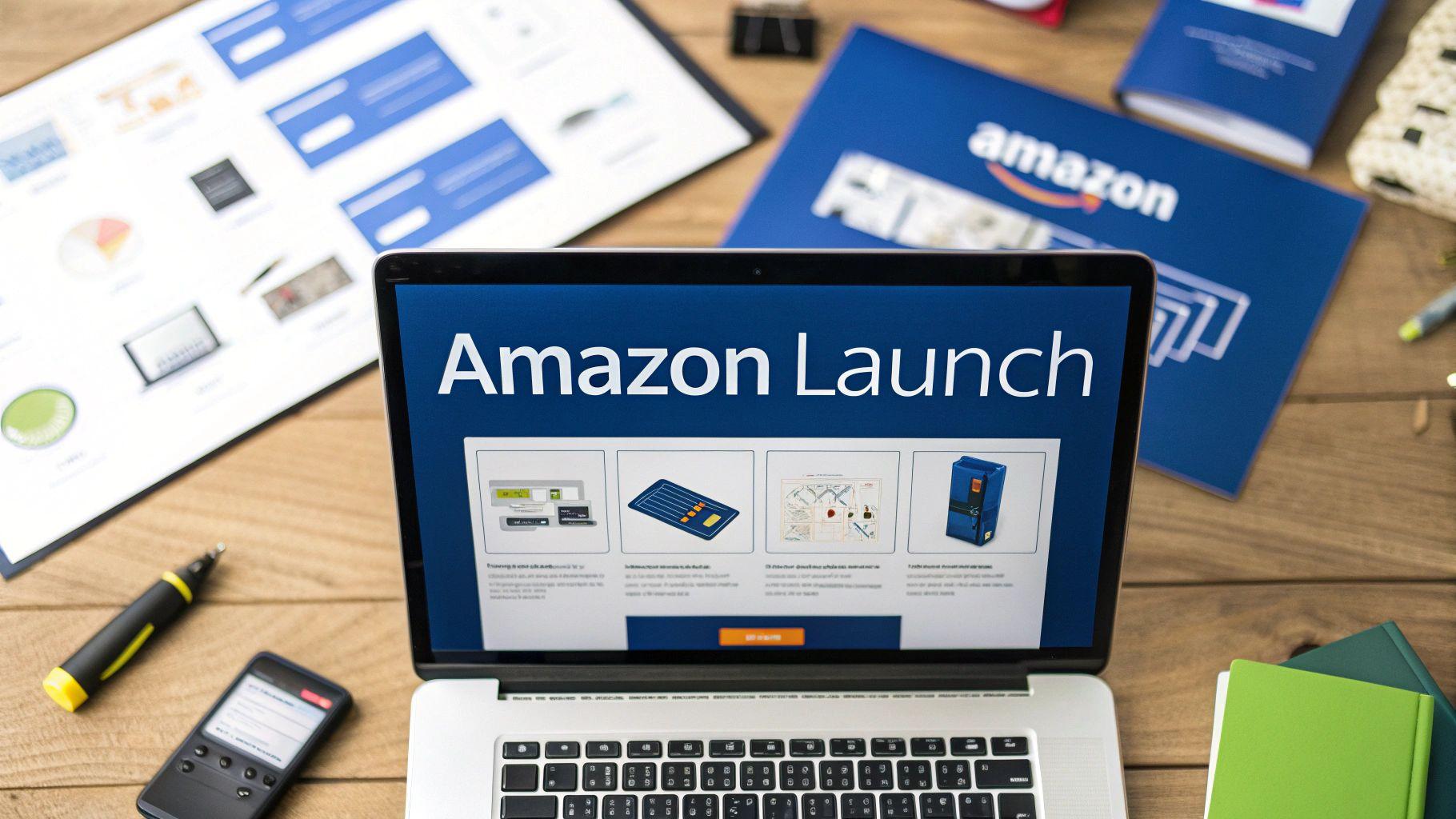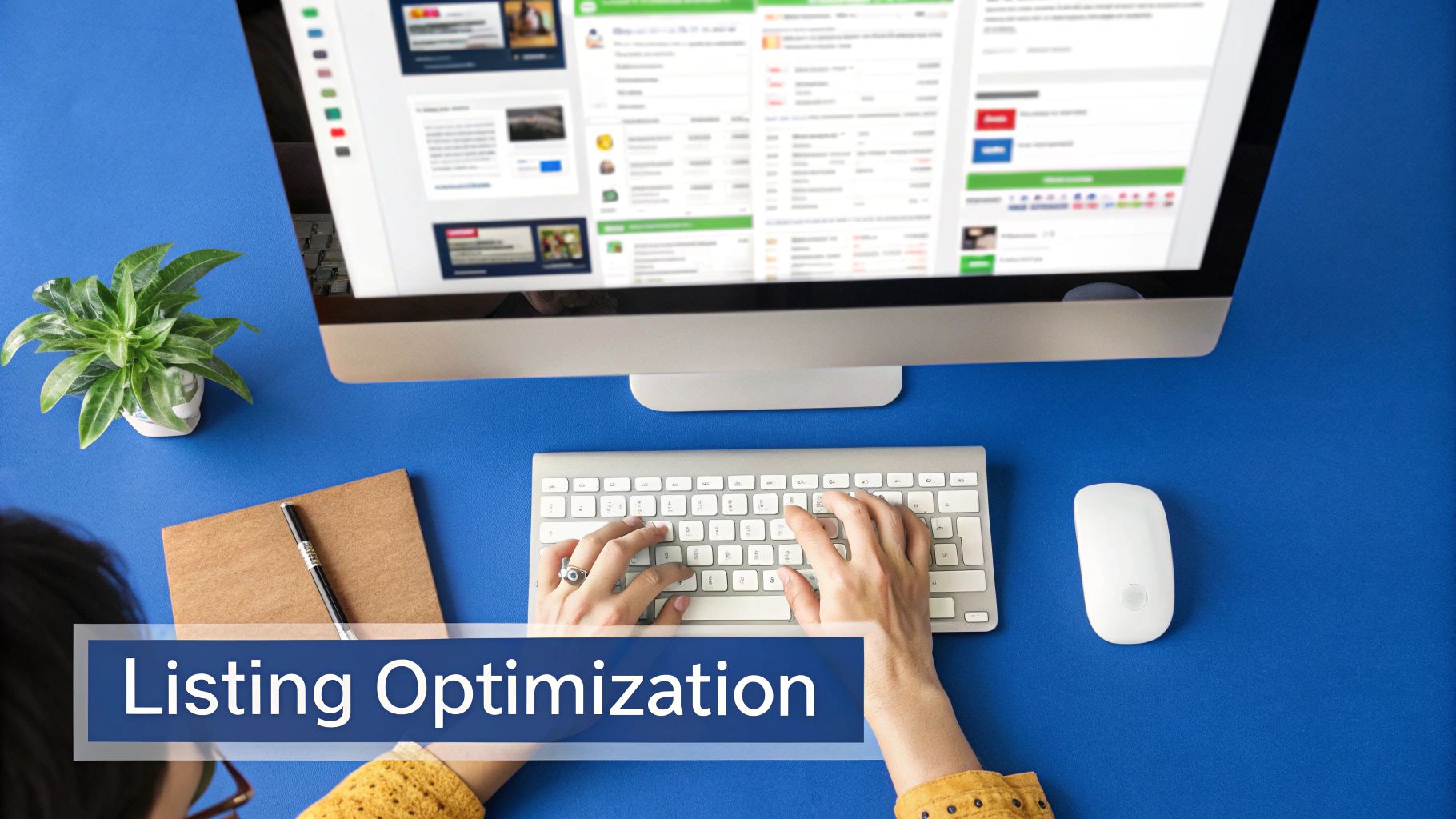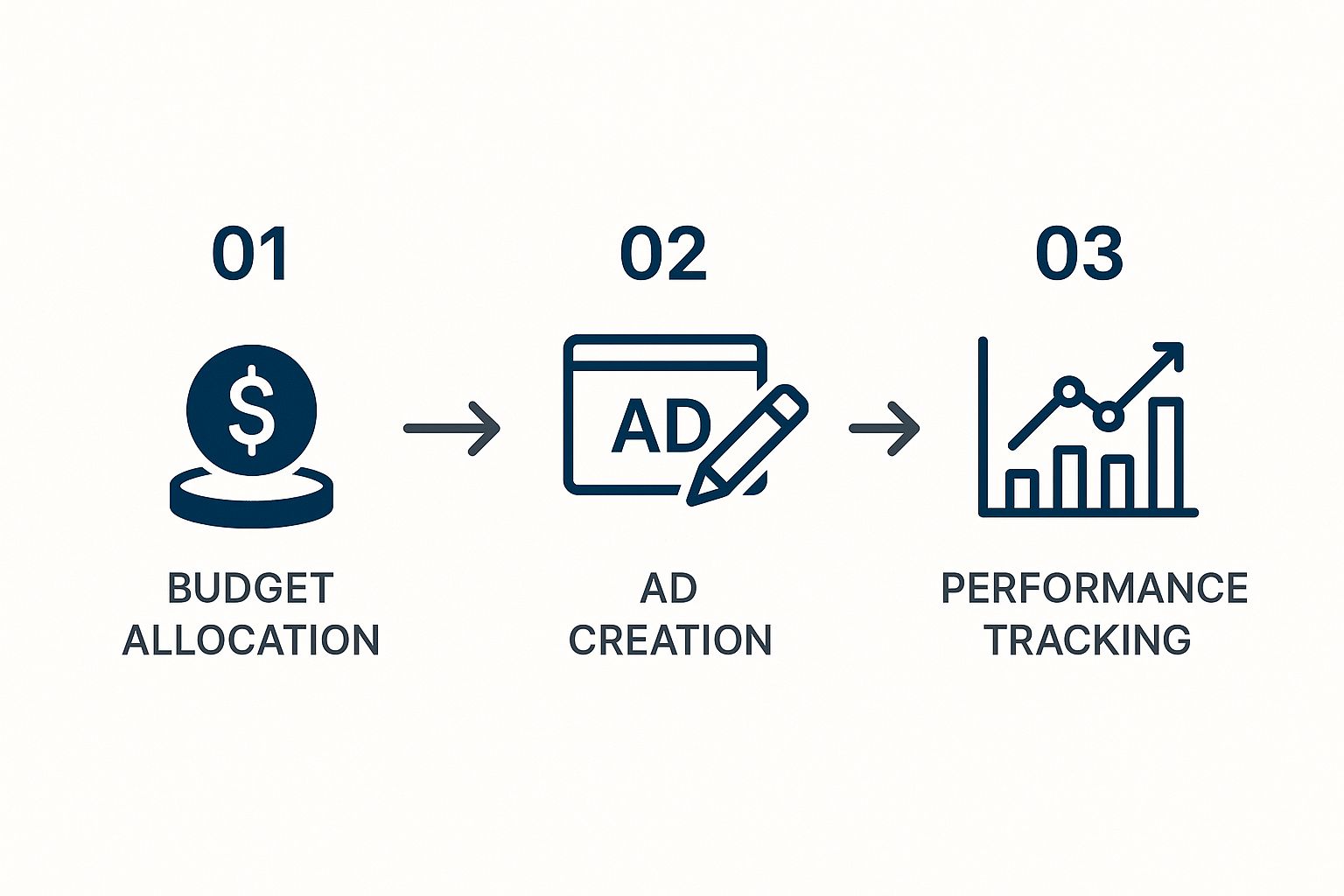Launching a Product on Amazon? PPC Is Your Lever for Organic Growth.
Learn how to launch a product on Amazon with proven strategies for success, research, PPC, and growth. Your expert guide to Amazon product launches.

Launching a product on Amazon comes down to one critical factor: sales velocity. But not just any sales. Success hinges on driving targeted, profitable conversions that signal to Amazon's A10 algorithm that your product is a market leader. Forget the outdated playbook of deep discounts and high-volume giveaways. In today's hyper-competitive marketplace, the algorithm rewards sustainable growth and genuine profitability, not manufactured sales spikes that torch your margins. This is how you build a resilient brand, not just a temporary bestseller.
Why the Old Amazon Launch Playbook Is Obsolete

The "wild west" era of Amazon launches—blasting your way to page one with aggressive giveaways and a simple, set-and-forget PPC campaign—is over. The marketplace has matured, competition has intensified, and the strategies that once guaranteed success are now ineffective at best and brand-damaging at worst.
This evolution is driven by two primary forces: a smarter algorithm and a more crowded platform. The A10 algorithm is far more sophisticated than its predecessors. It analyzes profitability, verified conversion rates, and even off-Amazon traffic, not just raw sales volume. This means the old tactics designed to game the system are now transparent liabilities that can backfire, harming your long-term organic potential.
The Flaws of the Outdated Model
The legacy launch strategy was a race to the bottom, reliant on a combination of these margin-destroying tactics:
- Massive Discounts: Slashing prices by 50-90% to generate a short-term sales rush. The critical flaw? You're training the algorithm that your product's true value is its rock-bottom sale price, making it incredibly difficult to establish a profitable price point later.
- Rebate Clubs: Using third-party services to orchestrate "purchases" is a direct violation of Amazon's Terms of Service and a fast track to account suspension.
- Giveaway Services: Paying for a flood of early orders from users with no purchase intent contaminates your conversion data, signaling to Amazon that genuine shoppers don't actually want your product.
These methods are fundamentally broken because they prioritize short-term manipulation over sustainable business-building. They attract bargain hunters, not brand loyalists, and obliterate your profit margins.
The Takeaway: The modern Amazon launch requires a new mindset. Obsolete tactics are now actively penalized. Success hinges on a conversion-optimized listing and a sophisticated PPC strategy designed to generate profitable sales velocity. For a deeper look at current best practices, see what's working in product launches right now. This guide will show you how to leverage PPC as a strategic tool for organic growth, using data to prove your product's market fit and kickstart a virtuous cycle of paid ads fueling profitable, durable organic sales.
Pinpointing Your Competitive Edge with Data-Driven Market Research

Before a single dollar is spent on advertising, understand this: your product's success is determined by the quality of your market research. A gut feeling is not a business strategy. What eCommerce leaders need is a data-backed plan to identify a profitable market position and deconstruct the competition.
The objective isn't merely to launch another product; it's to solve a specific, unmet need. Don't simply replicate the current bestseller at a lower price—that's a guaranteed race to the bottom. Instead, analyze why it's a bestseller. Scrutinize its reviews, particularly the 3- and 4-star ratings. What are customers complaining about? What features are they requesting? This is where you find your strategic opening.
Uncovering Profitable Niches and Market Gaps
The most successful brands target specific, underserved niches. Instead of launching a generic "whey protein powder," they identify an opportunity for a "keto-friendly, grass-fed whey protein for female athletes." This specificity reduces competition and creates hyper-relevance for a high-intent buyer segment.
A powerful tool for this is Amazon's own Product Opportunity Explorer. It provides real search volume, sales data, and growth trends, helping you spot categories with high demand and low competitive saturation. For instance, the "insulated tumbler" market may be saturated, but data might reveal a gap for a specific lid type, size, or color palette that major brands like Stanley have overlooked.
Here’s how to translate this into actionable research:
- Analyze Best-Seller Lists: Look for categories where top products exhibit clear weaknesses—poor-quality photography, non-existent A+ Content, or consistent 1- and 2-star reviews highlighting the same functional flaw.
- Monitor Off-Amazon Trends: Products that gain traction on platforms like TikTok, such as the Mighty Patch for acne, often create a surge in demand on Amazon. Monitoring these platforms allows you to anticipate and capture new market waves.
- Validate with Search Data: Use a robust keyword tool to confirm active search demand for the problem your product solves. High search volume for a term like "under-cabinet motion sensor light" validates that real market demand exists.
Deconstructing Your Competition
With a promising niche identified, it's time for a forensic analysis of your top three to five competitors. This extends far beyond a simple price comparison; it requires a deep dive into their entire market positioning.
The Takeaway: Your primary mission is to pinpoint competitor weaknesses and build a launch strategy that directly exploits them. If a competitor has a great product but weak branding and grainy photos, your advantage is superior marketing and creative. If their price is low but reviews consistently cite poor durability, your strategic angle is premium quality and long-term value.
Create a competitive analysis matrix to track key data points: price, review count, average rating, main image quality, and A+ Content usage. Look for strategic patterns. Are all top sellers priced above $40? A high-quality alternative at $34.99 could disrupt the market. For brands serious about scaling, this type of analysis is non-negotiable. Our guide on how to improve your Amazon ranking delves deeper into leveraging competitive data for visibility.
This research isn't a pre-launch checklist item; it's the foundation of your entire launch, informing everything from listing copy to PPC targeting. Knowing which keywords your competitors are underperforming on provides a ready-made roadmap for your initial advertising campaigns, transforming a speculative launch into a calculated market entry.
Engineering an Amazon Listing for Maximum Conversion

Your Amazon product detail page is your 24/7 digital salesperson. Its sole function is to convert traffic into sales. Excelling at this sends a powerful signal to Amazon's A10 algorithm, validating your product's market relevance. This is the mechanism that drives the sales velocity required for sustained organic ranking.
A high-performance listing moves beyond keyword stuffing. It anticipates customer questions, addresses potential objections, and tells a compelling brand story. This is how you build the conversion rate necessary to generate launch momentum.
Translate Features into High-Impact Benefits
Here’s a non-negotiable truth: customers don't buy features; they buy outcomes. Your copy must bridge the gap between your product's specifications and the customer's needs.
Instead of stating your water bottle has "triple-wall insulation," demonstrate the result: "Keeps your drink ice-cold for 24 hours, ensuring your last sip on a hot day is as refreshing as the first." Every bullet point and image must be framed around a tangible, real-world benefit.
Make Your Visuals Your Primary Sales Tool
Humans process visual information far more efficiently than text. Your image stack and video are your most powerful assets for making a rapid, decisive impact.
- Image Stack: The main image must command attention and drive clicks from the search results page. Subsequent images should use a mix of lifestyle shots (showing the product in use), infographics (to visually communicate key benefits), and comparison charts (to establish superiority over competitors).
- Product Video: A concise, high-energy video is your opportunity to demonstrate functionality, clarify common points of confusion, and build an emotional connection with your brand.
- A+ Content: This is your dedicated brand space on the detail page. Leverage A+ modules to articulate your brand story, provide in-depth product details, and build trust. Treat it as your premium digital brochure.
To help you structure this, here’s a breakdown of the key listing elements and their strategic objectives.
Key Amazon Listing Conversion Elements
| Element | Primary Goal | Best Practice Example |
|---|---|---|
| Product Title | Index for key terms & drive clicks | "Brand Name 24oz Insulated Water Bottle - Keeps Drinks Cold 24 Hrs, Leak-Proof Lid for Gym & Hiking" |
| Hero Images | Capture attention & showcase quality | A high-resolution, clutter-free image of the product on a pure white background. |
| Bullet Points | Convert shoppers by highlighting 5 core benefits | "ICE-COLD FOR 24 HOURS: Triple-wall insulation locks in temperature so your last sip is as refreshing as the first." |
| A+ Content | Build brand equity & increase conversion | Use high-quality lifestyle images and comparison charts to show the product in use and differentiate it. |
| Product Video | Demonstrate value & overcome objections | A 30-second video showing someone easily using the leak-proof lid during a workout. |
| Reviews & Ratings | Establish social proof & build trust | Aim for a steady stream of authentic reviews to signal ongoing customer satisfaction. |
Redefining "Social Proof" in 2024
The old paradigm was to secure a handful of 5-star reviews and call it a day. While a high star rating remains critical, today's shoppers are more sophisticated.
Data Insight: A deep dive into nearly 30,000 product launches revealed that the most successful products didn't always have a higher percentage of 4.5+ star ratings. This indicates that buyers are weighing other signals, such as the total volume and velocity of new reviews. You can see the full analysis on what separates top product launches from the rest.
What does this mean for your launch strategy? Your objective isn't just to acquire 15 flawless 5-star reviews. A product with 150 reviews and a 4.4-star rating often appears more authentic and trustworthy, as it demonstrates a real community of buyers has tested it. Your focus must shift to building a continuous flow of genuine customer feedback.
The Takeaway: Your listing is the engine of your launch. When optimized for conversion, every dollar invested in advertising works exponentially harder, initiating the flywheel of sales and reviews that leads to long-term profitability and market leadership.
Using PPC as the Engine for Your Organic Growth
This is the inflection point where preparation meets execution. The most common strategic error we see brands make is treating Pay-Per-Click (PPC) advertising as a mere sales channel or a necessary evil to be minimized. This thinking is a relic of the old playbook.
For a modern Amazon launch, you must reframe PPC as the primary engine of your organic growth.
During the launch phase, your primary objective is not a low Advertising Cost of Sale (ACoS). The mission is to use PPC aggressively to acquire two strategic assets: data and sales velocity. This initial investment is what ignites the "flywheel effect." Your paid ads generate initial sales and reviews, which signals relevance to the Amazon algorithm. Amazon rewards this relevance with improved organic rankings, which in turn drive more profitable, organic sales.
This graphic illustrates how PPC directly fuels your overall performance.

The power of this model lies in its self-sustaining nature. Each stage reinforces the next, creating a virtuous cycle of growth. This is how you transform ad spend from a short-term expense into a long-term investment in your product's market position.
Structuring Launch Campaigns for Data and Dominance
An unstructured, "spray and pray" PPC approach is a recipe for burning through your budget with minimal return. A sophisticated launch requires a structured campaign framework designed to achieve two simultaneous goals: discover high-converting search terms and dominate the keywords that drive your market.
Here is a proven, performance-focused launch structure:
- Automatic Campaign (Reconnaissance): Deploy an automatic campaign to let Amazon's algorithm test your product against a wide array of customer searches and competitor product pages. This is your primary data-gathering tool for uncovering unexpected, high-intent keywords and ASIN targets.
- Broad Match Campaign (Discovery): Take the top keyword concepts from your initial research and place them in a Broad Match campaign. This widens your net to capture long-tail variations and related search queries, expanding your pool of potential targets.
- Phrase & Exact Match Campaigns (Domination): This is where you capitalize on proven performance. As your Auto and Broad campaigns generate conversion data, "harvest" the exact search terms that are driving sales. Move these high-performers into dedicated Phrase and Exact Match campaigns where you can bid more aggressively to secure top-of-search placement.
This tiered structure enables strategic budget allocation. You invest moderately in broad discovery campaigns and concentrate your primary budget on the keywords proven to drive profitable sales. For a more detailed breakdown, our complete guide on what is Amazon PPC explains these campaign types in full.
From Data Analysis to Strategic Bidding
Your early PPC reports are a goldmine of market intelligence. Go beyond a cursory glance at ACoS. You need to be performing a weekly deep dive into your Search Term Report, asking critical questions:
- Which search terms are generating the highest click-through rate (CTR)?
- Which terms are converting into actual sales?
- Which irrelevant terms are draining my budget? (Isolate and add these as negative keywords immediately.)
When you identify a keyword with a strong conversion rate—for instance, 15% or higher—this is a clear market signal. Shoppers using that term are finding your product to be the ideal solution. This is your cue to act decisively.
Increase your bid on that exact keyword and compete aggressively for the top placement. Dominating that position will accelerate your flywheel, drive incremental sales, and solidify your organic rank for that high-value term.
The Takeaway: This is not simply "running ads." It's a calculated strategy to prove your product's market viability to Amazon's algorithm. By using PPC to generate targeted sales on your most important keywords, you are training the algorithm to recognize you as the market leader, converting paid momentum into sustainable, long-term organic success.
Maintaining Momentum Beyond Launch Day
A successful launch isn't the finish line; it's the start of a critical 90-day period. Your initial efforts got the flywheel spinning. Now, the strategic focus shifts to converting that initial momentum into a self-sustaining growth engine. Dropping the ball here is a classic error that leads promising products into a sales decline.
The strategic objective has evolved from fighting for initial visibility to defending and expanding your newly acquired rank. Your goals are now to generate a consistent flow of authentic reviews, maintain sales velocity with strategic promotions, and optimize your PPC campaigns based on a growing set of performance data.
Securing Early Reviews to Build Trust
Nothing validates a purchase decision like recent, authentic reviews. While the star rating is important, the velocity of new reviews sends a powerful signal to both customers and Amazon's algorithm.
Your first action should be enrolling in Amazon Vine. It is the most efficient and policy-compliant method for generating early social proof. Through Vine, you can secure up to 30 initial reviews from Amazon's pool of vetted reviewers, moving your product out of the zero-review danger zone.
Post-Vine, implement a gentle, policy-compliant follow-up strategy. Use Amazon's native "Request a Review" functionality. The key is to avoid being intrusive. A single, well-timed request for honest feedback is sufficient to increase your review acquisition rate over time.
Using Smart Promotions to Maintain Sales Velocity
With traffic established, the focus turns to conversion. This is where promotions become a valuable lever, but forget the margin-killing discounts of the past. We're talking about targeted, strategic offers.
- Lightning Deals: Once eligible, these time-sensitive promotions can generate a significant, short-term sales spike, ideal for boosting rank or clearing excess inventory.
- Coupons: A simple digital coupon, even for just 5% or 10% off, provides a powerful visual cue in search results. The orange badge increases click-through rates and gives you an immediate competitive edge.
The goal isn't to devalue your product but to use these tools to drive incremental sales and support the velocity your PPC campaigns are generating. This helps establish a stable sales floor.
Expert Take: An Amazon launch is a full-funnel campaign blending research, optimization, advertising, and continuous management. Strong initial sales velocity is the single most important signal you can send to Amazon’s A9/A10 ranking algorithm. To see how these pillars fit together, review the core components of an effective Amazon product launch strategy from SalesDuo.
Maintaining momentum requires active, data-driven management. By focusing on consistent review generation and using promotions to sustain sales, you create the optimal conditions for your PPC campaigns to cement your product's position in the market.
Common Questions We Hear About Amazon Launches
Even for seasoned eCommerce leaders, launching a new product on Amazon presents challenges. The marketplace evolves constantly, and yesterday's strategies rarely deliver today's results. Here are our no-nonsense answers to the most common questions we field from brands.
How Much Should I Budget for an Amazon Product Launch?
There is no one-size-fits-all number. A more strategic approach is to budget based on performance goals, not a fixed dollar amount. A successful launch budget funds three core components: sufficient inventory to avoid stockouts, professional-grade creative assets, and an aggressive advertising spend to generate initial velocity.
For your Pay-Per-Click (PPC) campaigns, a functional baseline is to allocate 10-20% of your first month's revenue target to ad spend. However, this is not a cost; it's an investment in data acquisition and sales velocity, which are the primary drivers of organic rank. The key performance indicators (KPIs) to monitor are not just Return on Ad Spend (ROAS) but, more importantly, Total ACoS (TACoS), which measures your advertising efficiency against total sales.
How Many Reviews Do I Need to Get Started?
The obsession with hitting a specific number of reviews is outdated.
While securing 10 to 15 early reviews via a program like Amazon Vine provides a crucial foundation, the algorithm now prioritizes the velocity and authenticity of new reviews over a static total.
Market data shows that shoppers view the recency and consistent flow of reviews as a more powerful form of social proof. A steady stream of genuine, detailed feedback from verified purchasers builds more trust than a sudden burst of generic ratings that occurred months ago. Your strategy should be to create a superior customer experience that organically encourages reviews long past the launch phase.
Expert Take: The old advice of hitting a magic number of reviews is dead. A product with 50 recent, well-written reviews will almost always build more trust and rank better than a competitor with 100 reviews from two years ago.
Is the Amazon "Honeymoon Period" a Real Thing?
Yes, absolutely. While not an officially documented feature, the "honeymoon period" is a well-observed algorithmic boost given to new ASINs. This window of opportunity typically lasts for the first 30 to 60 days post-launch.
During this period, Amazon actively tests your new product's relevance and conversion potential across a variety of keywords. This means you can achieve significant ranking with fewer sales than an established competitor. It is your prime opportunity to make a decisive impact.
To capitalize on this, your listing must be fully optimized before going live, and your PPC campaigns must be ready for immediate activation. Driving strong sales and a high conversion rate from day one signals to Amazon that your product is a market winner, setting the stage for long-term organic dominance.
Ready to move beyond generic advice and implement a profitable, data-driven launch strategy? At Headline Marketing Agency, we leverage advanced analytics and expert campaign management to transform your ad spend into sustainable organic growth and market leadership. Learn how we can scale your brand on Amazon.
Wollen Sie Ihre Amazon PPC-Performance aufs nächste Level bringen?
Lassen Sie Ihre Amazon PPC-Kampagnen professionell analysieren und entdecken Sie neue Wachstumsmöglichkeiten.